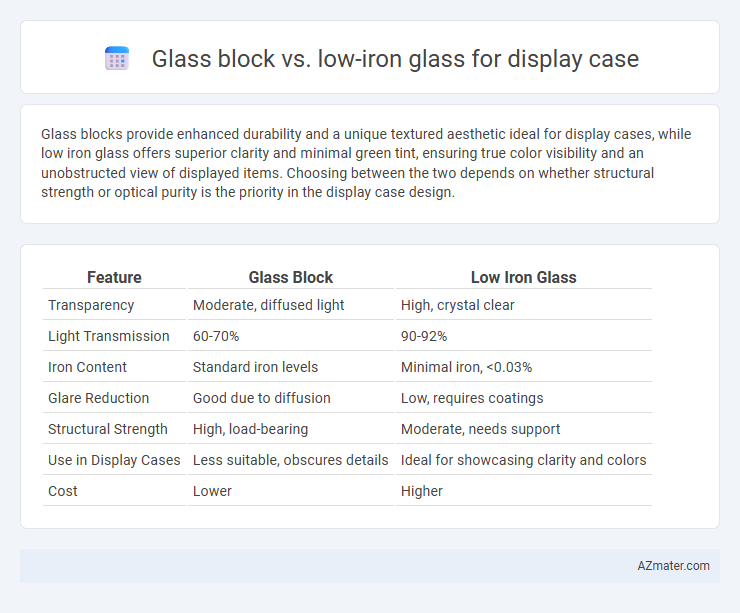Glass blocks provide enhanced durability and a unique textured aesthetic ideal for display cases, while low iron glass offers superior clarity and minimal green tint, ensuring true color visibility and an unobstructed view of displayed items. Choosing between the two depends on whether structural strength or optical purity is the priority in the display case design.
Table of Comparison
| Feature | Glass Block | Low Iron Glass |
|---|---|---|
| Transparency | Moderate, diffused light | High, crystal clear |
| Light Transmission | 60-70% | 90-92% |
| Iron Content | Standard iron levels | Minimal iron, <0.03% |
| Glare Reduction | Good due to diffusion | Low, requires coatings |
| Structural Strength | High, load-bearing | Moderate, needs support |
| Use in Display Cases | Less suitable, obscures details | Ideal for showcasing clarity and colors |
| Cost | Lower | Higher |
Introduction to Display Case Glass Options
Glass block offers durability and enhanced privacy with its thick, textured surface ideal for display cases requiring both security and light diffusion. Low iron glass provides superior clarity and true color representation, making it perfect for showcases where visibility and visual appeal are paramount. Choosing between glass block and low iron glass depends on balancing protection needs with the desire for optimal transparency and aesthetics in display cases.
Understanding Glass Block: Features and Applications
Glass block offers durability, privacy, and light diffusion, making it ideal for display cases requiring structural strength and aesthetic appeal. Its thick, textured surface enhances security and obscures visibility while allowing natural light to pass through, unlike low iron glass, which provides maximum transparency with minimal color distortion but less impact resistance. Glass block's unique geometric patterns and insulation properties contribute to energy efficiency and a distinctive visual effect within retail or museum display environments.
What is Low Iron Glass? Key Characteristics
Low iron glass is a highly transparent glass type with reduced iron content, providing superior clarity and minimal greenish tint compared to standard glass. It typically has a light transmittance of around 91%, enhancing color accuracy and visibility in display cases. This glass is prized for its strength, durability, and ability to showcase objects with true-to-life colors, making it ideal for museum-quality and high-end retail displays.
Clarity and Transparency: Which Glass Performs Better?
Low iron glass offers superior clarity and transparency compared to glass block due to its reduced iron content, which minimizes the greenish tint typically found in standard glass. This makes low iron glass ideal for display cases where true color representation and maximum light transmission are critical. Glass block, while durable and decorative, has a textured surface that diffuses light and reduces visual clarity, making it less suitable for displays requiring precise visibility.
Durability and Strength: Glass Block vs. Low Iron Glass
Glass block offers superior durability and impact resistance due to its thick, molded construction, making it ideal for high-traffic display cases requiring robust protection. Low iron glass, while providing exceptional clarity and minimal green tint for enhanced visual appeal, is thinner and more fragile, necessitating careful handling and reinforcement in display applications. For long-lasting strength and security, glass blocks outperform low iron glass in terms of resistance to breakage and structural support.
Aesthetic Appeal in Display Cases
Glass blocks provide a unique textured aesthetic that diffuses light and adds dimensionality to display cases, enhancing visual interest with a subtle, frosted appearance. Low iron glass offers superior clarity and a near-transparent look, allowing the true colors and details of displayed items to stand out without distortion. Choosing between glass block and low iron glass depends on whether the goal is to create a distinctive, architectural effect or a clean, unobstructed view that emphasizes product presentation.
Security and Protection for Displayed Items
Glass block offers enhanced security for display cases due to its thick, durable structure and resistance to breakage, making it ideal for protecting valuable items from theft and vandalism. Low iron glass provides superior clarity and minimal color distortion, but it is generally more fragile and requires additional reinforcement to ensure adequate protection. For maximum security and protection, glass block is preferred in high-risk environments, while low iron glass suits displays prioritizing visual aesthetics with moderate security needs.
Maintenance and Cleaning Considerations
Glass blocks require minimal maintenance due to their thick, durable structure that resists scratches and cracks, making cleaning straightforward with just mild soap and water. Low iron glass, while offering superior clarity and a modern look, demands more frequent cleaning to maintain its pristine appearance, as fingerprints and smudges are more visible on its surface. Both materials benefit from non-abrasive cleaning tools, but low iron glass may need specialized glass cleaners to prevent streaks and preserve its transparency over time.
Cost Comparison: Glass Block vs. Low Iron Glass
Glass block typically costs more upfront due to its thickness and manufacturing complexity, averaging around $30 to $50 per square foot, while low iron glass generally ranges from $20 to $40 per square foot depending on thickness and supplier. Installation costs for glass block can be higher because it requires mortar and more labor-intensive fitting compared to low iron glass's simpler mounting and framing processes. Long-term benefits such as enhanced durability and insulation properties of glass block may offset initial expenses, whereas low iron glass excels in clarity and aesthetic appeal but may require more frequent maintenance or replacement in high-traffic display cases.
Choosing the Best Glass for Your Display Case
When choosing the best glass for your display case, consider that low iron glass offers superior clarity and minimal green tint compared to standard glass blocks, allowing for true color representation of displayed items. Glass blocks provide enhanced structural durability and a textured aesthetic but may distort visibility due to their thickness and pattern. Prioritize display clarity and visual impact with low iron glass for showcasing valuable or detailed objects, while glass blocks suit designs requiring added strength and privacy.

Infographic: Glass block vs Low iron glass for Display case
 azmater.com
azmater.com